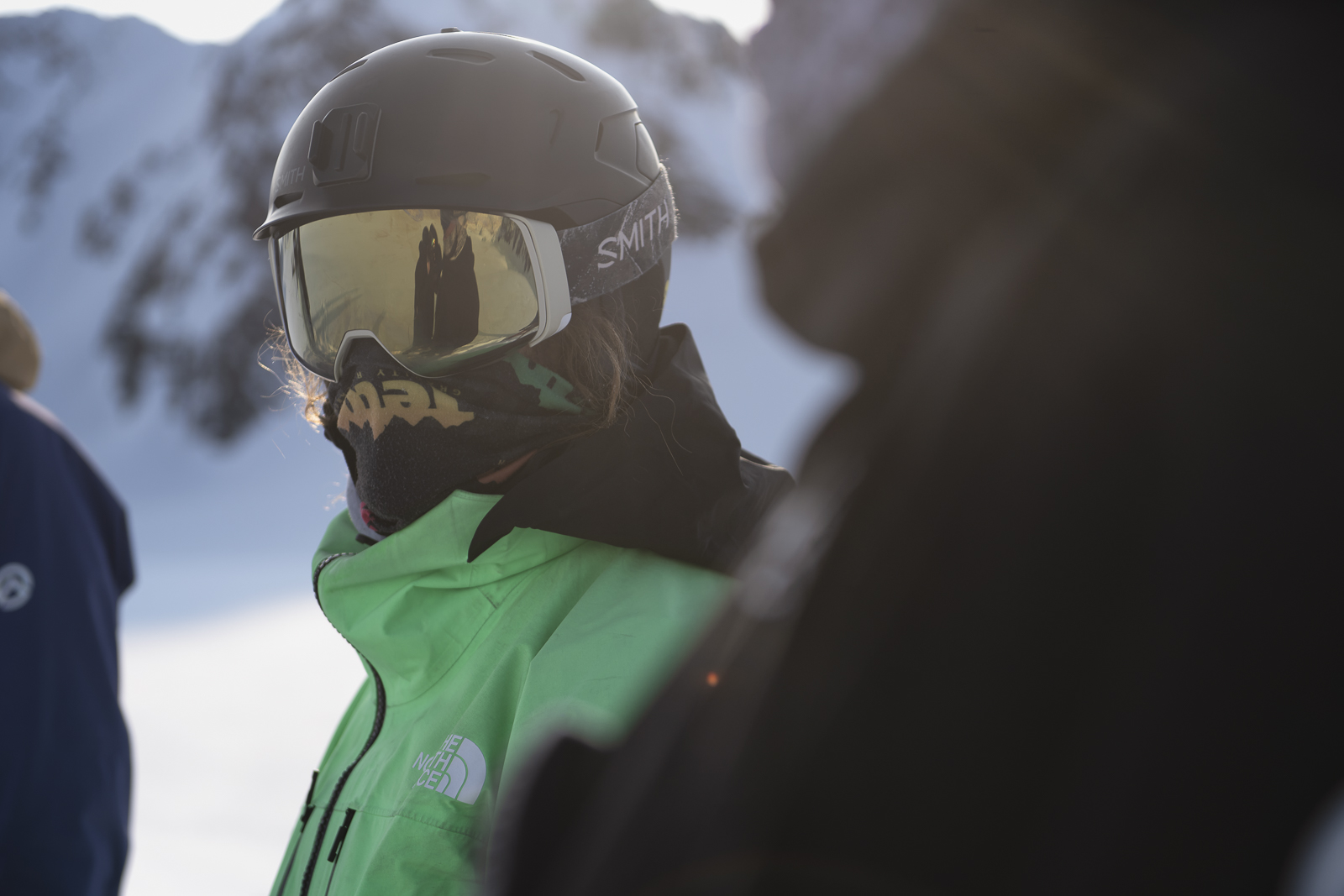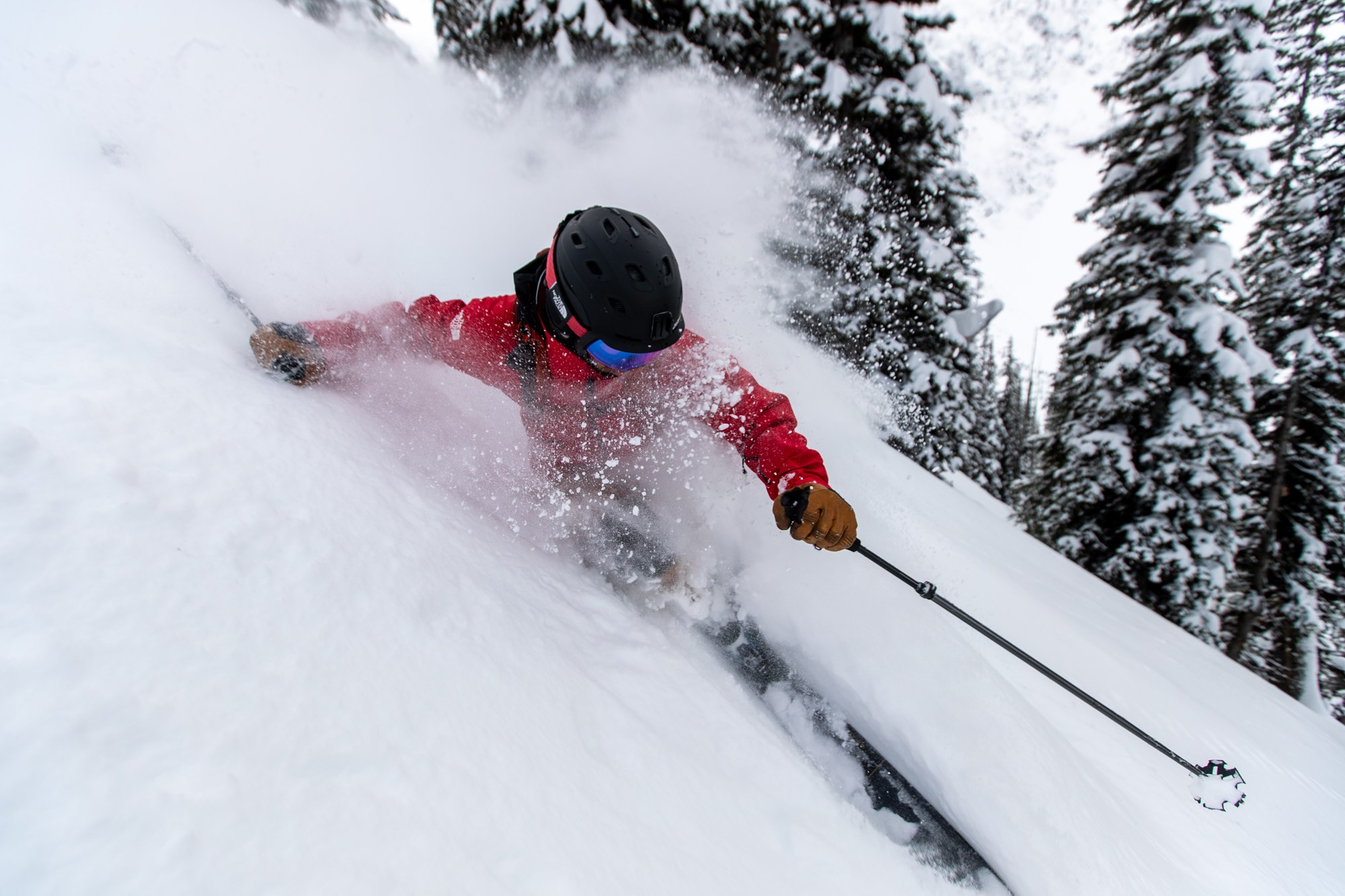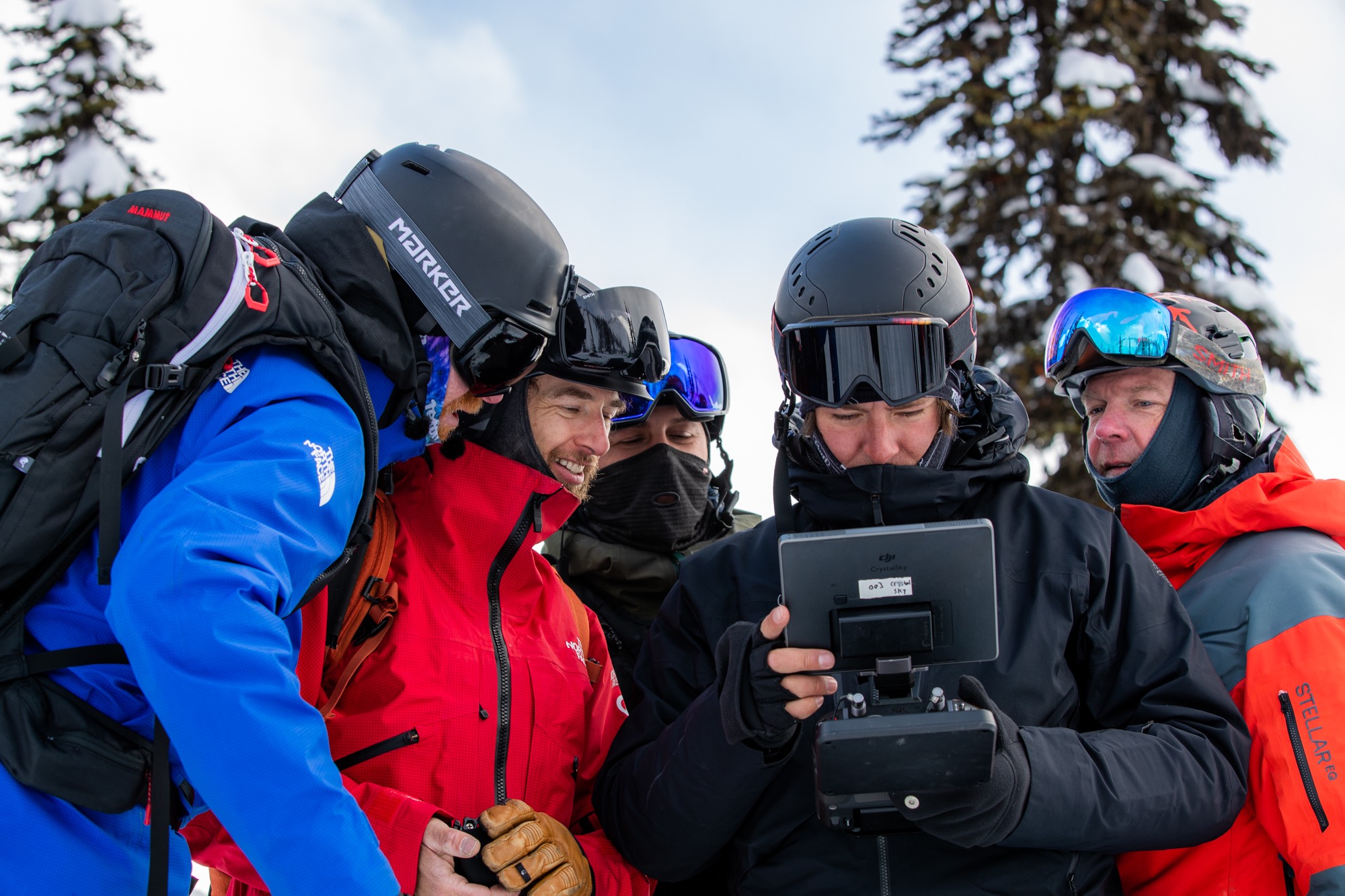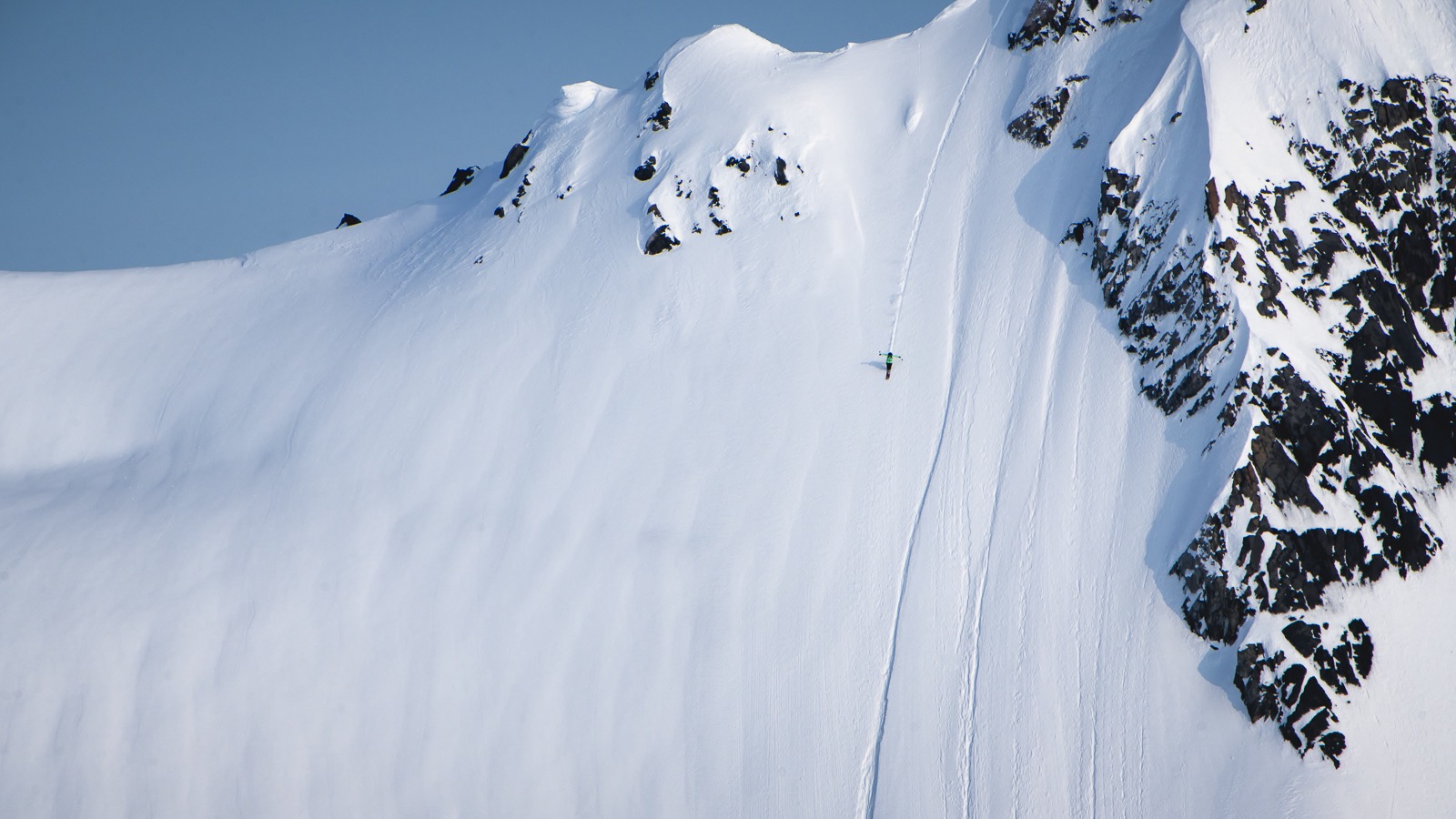
Sage is a Jedi Master. Photo: Nic Alegre
Born and raised in the hamlet of Alta, Wyoming, under the shadow of the Grand Teton, Sage Cattabriga-Alosa needs no introduction. He now calls Bend, OR home and continues to be a staple in TGR's film line-up. Sponsored by The North Face and Atomic, this legends has found his groove on and off the slopes. Watch Sage's episode of Legends In the Making.
Let’s begin with where you filmed for Legend Has It.
Sweet. Yeah, I was psyched to get back to Alaska this year. It had been like over five years and I got to go to the North Chugach. Alaska has been a special place in my heart for sure. I’ve had like, quite a bit of experience up there, but then also, yeah, kind of had like several years off. And so it was the magic of remembering what it's like up there, and then also like the reality of remembering what the reality is like as well. You know what I'm saying? The magical side is like having bigger space, more room and potential for like the spine features and just the cool–I guess what I've always loved about skiing is the features, right? Like whether it's the way the wind sculpts the snow, the way the mountain just holds the snow a certain way.

Sage showing the kids (in this case Parkin Costain and Maddie Voisin) how it's done in the Alaska backcountry. Photo: Nic Alegre
Yeah, different features that are out there and how you can interact with those features, it’s special.
That's like one of the best parts in Alaska, having a big amount of alpine terrain and a bunch of space and cool features. So yeah, that was the magic. And then the reality there's that you’re skiing in alpine terrain. So you need really good weather and then, like, the stars aligning experience of having a stable snowpack, deep enough snowpack, good enough snow, like great quality of snow. Stability of snow and the terrain, light, like all coming together it I was like, oh right; It's a lot harder up here. You need a lot more time and yeah, it's kind of like it's more expensive and you're risking more, you know a little bit. So yeah, those realities like, oh right.
I forgot the hard parts, but I remembered all the glory and now, you know, you're just like, yeah, kind of battling waiting around or something.
Well, I'm going to throw it back all the way back and ask about your origins, since every legend needs a backstory.
Well, I grew up skiing at Grand Targhee, grew up in Alta, WY. So just over the hill here from Jackson. I started skiing in elementary school, we got to go skiing with the ski program every Friday for six weeks. Then I joined the local ski foundation, like ski team, essentially, that got me an inexpensive pass and just gave me the ability to go to the ski hill all the time. And so by being a part of the ski club, that was where I learned how to make a good turn. I was essentially working on racing at the time, but growing up on a powder-oriented mountain, racing didn't become my strong suit. And so that was sort of like, yeah, that was kind of the early days. And I guess when I was in high school is when TGR first started coming out with movies. And so me and my friends, we would be at lunch break, we would watch TGR movies. And so that was my first inspiration and first sort of seeing what the pro skier world was becoming. And I didn't really ever think that that's what I would do. It just sort of was like, wow, that looks amazing. And I love skiing and I want to ski like that someday. And so then I graduated high school, moved to Oregon and ended up meeting Chris Collins, who just got into the ski hall of fame this last year. I met him up at the ski hill up at Mount Bachelor, and started skiing with him. And he was like, you should move to Utah. That's what I, you know, I kind of said I wanted to pursue skiing to him. At the time I was like, I want to go on the freeskiing tour, which wasn't the freeride world tour, but it was a competitive tour at the time in North America. And he was like, why do you why are you going to do that? You should just move to Utah and just get a job at one of the lodges. And Utah at the time is this industry hub. And so I did. I got a job at Alta and started hanging out with pros, you know, hanging out with pro skiers. And then like one thing led to another, and all of a sudden I was like basically in this peer group of pro skiers that were better than me that took me under their wing and they were filming with TGR. And eventually I was at a jump that TGR was filming and that kind of got me started. And so it was like becoming a pro was like this slow process, right? Like I was hanging out with pro skiers. I got into a ski movie, but that didn't mean I was a pro skier.

Photo: Jeremy Allen
And how old were you?
I was like in my early 20s, and then it took five years probably of doing that, you know, where I like got my foot in the door the next year. I was like, well, you're not just like filming with TGR just because you got a couple shots in the movie. But if you come up to Jackson, you might get some more shots in the next movie. And so I would just work all week, I'd come up here, I'd film up here with the Jackson crew and I film with the Utah crew. And then like year two, it was like I had some more shots in the movie. And then year three, they took me on a trip. And then year four I went to Alaska. But I was still like, I wasn't even really a pro. I mean, I got some free gear at that point, but like six years into it, maybe, you know, now 26 or something, I was like, okay, I think this is my job now. I think this is what I do. I think I can pay my own rent and health insurance now. So that was sort of an interesting path because there isn't really a line that you follow. Fast forward, I think about how many movies they've [TGR] made and how many I've been a part of, it's been like 85 percent of them.
Crazy.
I think maybe 2000 or 2001 when I was in the first movie in Russia. That's over 20 years of movies. Yeah, it's kind of crazy to have been like this thing that I grew up with, but then I also was such a big part of it for so long. There wasn’t a moment where I was like, I want to be a pro skier. I was just like, I love skiing and I want to do this as much as I can. How can I do that? And that just slowly evolved into like, yeah, that manifestation or that creation of just being in the place and the right time and meeting the right people. Like I said, the first couple of years it was like I kind of got my foot in the door, but there was no guarantee that I was in the movie and there was this like moment that Todd and Steve talk about where they were like, you know, this kid doesn't have any sponsors that support us. And Todd was just like, well, who cares! He has the vibe and let's get him on the sponsors then. And essentially they helped forge those first connections with my sponsors [at the time], sponsors that TGR was already working with. And what's cool is that they've just continued throughout their the career of TGR–like money makes the movie and the athletes that have the support from [the movie] sponsors are the athletes that are in it–
Right.
But every year there's a handful of athletes where Todd and Steve have just remained like, we know that this guy or this girl doesn't have any major sponsor that's paying for this movie, but they have an awesome vibe and they're part of the crew and let's get them in anyway. And then eventually those things sort of like lead to being productive for both sides of, you know, the coin or whatever. But it's just cool that they've always had that passion that has kind of driven that sort of connection between the athletes and whether it's like worked out on a sponsorship, like kind of cohesion or not. And it can't all just be like, well, this guy's got a great vibe and there's no support, you know, the bottom line, there's still work, it still has to work, so that's why that's so cool.

Sage loves the art of flight. Photo: Nic Alegre
Moving from the origins of your career, do you have any specific highlights over the last 20-something years that stand out? I mean, you’re basically synonymous with TGR.
There's been like a handful of standout moments and like a couple of them have been these moments that when I go back to talking about how skiing is almost this like manifestation or this like channeling in some ways. And it's sort of like when all things align and you just know it like when it's all a “hell yeah”. And you're just like, oh, there's this thing I got to do. And there's been a few moments like that. One was like what initially got me into the TGR movie, which was the double front flip over Pyramid Gap. And that was like I had this we had I had hit the gap the night the day before. I knew TGR was going to be back with a heli the next day. I was washing dishes at the lodge and I had this moment where I stopped and closed my eyes and visualized doing a double front flip, I got full body goosebumps, I landed the double front flip and skied away in my head and I was like, yeah, just like goosebumps and like just buzzing. And I was just like, whoa, that's crazy. And the next day I did a three and did a front flip. I didn't tell anybody. I didn't say anything. And I just told myself like you've already done this. And it was like this the first time I'd ever had manifested something in my life of such great magnitude in such a short window. And I just went for it and it sort of was miraculous that it even worked. I didn't know how to do one, I had never done it before, and I practically have never done one since. And then there was another time when I did like the spine line to crevasse gap in Petersburg [AK]. And, you know, it's like maybe a 80 foot crevasse gap, maybe it was 60. It's a pretty big step-down, a pretty big gap, all natural. I saw it. Usually you see these crevasses and you see it from one perspective and you're like, holy shit, can you jump that? And then you see it from another perspective and you're like, that's 200 feet, that's impossible. And I saw it and it just started to work. And I had a similar moment where I was like, I have to get back up there, there's something I have to do. No build, no jump, no like walking to the edge and scoping how big it was. I just had this vision and it was just like, there's something I have to do. I went and hit it. Ten minutes later, it was in the shade and I had flat spun over it, landed it in good light. And it was just another one of those things where it was just this almost like external–something like support or, you know, like spirit or manifestation just like came through me. It was just like, there's something that has to happen. And so that was just like probably my career highlight, you know, among some others.
That's crazy. I have no words.
You know, and I guess that's what I kind of go back to where I'm like, you're not going to get those every year every time you go out or every filming trip, it's just not realistic that moments like that can come together. You can manifest a lot and you can create a lot and you can push and dig deep and like work it blue. And like, you know, make stuff happen. But I've just found that like, yeah, those times when it all aligns are kind of rare. And to just accept them when they come is part of the whole experience and accept that thing. It might not happen all the time and be okay with that too.

Sage, with partner in crime Ian McIntosh, from Magic Hour. Photo: Jeremy Allen
That's perfect advice. I just interviewed Ian [McIntosh] the other week and I asked about your relationship and where it started long ago on a heli trip to AK. Filming together in AK, two legends, it must have been special. His self-described story is he was all fired up to ski and initially, felt like you two didn’t hit it off. Tell me about that and your friendship today.
Yeah, McIntosh came in. He was off the freeride tour and he was like, you know, kind of this hard-charging, had-something-to-prove kind of attitude, right? The way we work in filming is very much like we're all part of this crew. We're all working together to make this film, to make this trip, your decision affects my decision. We're all like in this tight cohesive unit that is, you know, working in a remote environment and with limited resources, limited support and it's like it's not like skiing individually, but it's a group dynamic and McIntosh had come in like not really experiencing that. And he came in unaware of that perspective. He was just so stoked to be there that he was unaware of the bigger picture. And that first trip I definitely was like, I don't know if I will go on another trip with this guy, he’s a lot to handle [chuckles]. And then he quickly became my favorite person to go on trips with. And during that experience, he shifted through that period of being like, a hungry guy, you know, just very passionate, singularly-focused on his own experience and slowly understood that it's a group experience and that he's part of it. And so the next time we went out, he had already changed his perspective, and our friendship and bond just only grew from there. I mean, we've been friends for a long time, and like I said, like he's one of my favorite people to be in the mountains with. I love working with him the way he looks at things and he's like such a team player. It's so ridiculous now how much of a team player he is, you know, compared to that first year. But he's just so passionate, the passion and stoke hasn't changed. He's so knowledgeable about the terrain. He lives and breathes and eats and sleeps the experience. And so his perspective around the terrain, the trip, the logistics. Now he's a guide. So he has basically all the aspects of making that experience like the most ideal. And now we’re kind of like brothers at this point.

Chimping during the filming of Magic Hour. Photo: Jeremy Allen
So you've had a very successful and long career; can you give some advice or some keys to success for the next generation who are looking to follow in your footsteps?
Yeah, I mean, I think the biggest thing is like I said, that my overall mantra in life is: if it's not a hell yeah, it's a no–or being patient essentially is what that means and not swimming upstream when it’s unnecessary.
Would you say your intuition has been a main factor as well?
Yeah. Just having that gut feeling. That's what I mean about patience. I go out every day and I don't I have a plan, I have an idea, but I don't have an objective–or I might have an objective– and because I'm willing to drop that objective at any point based on the information that I get, being flexible and being open and being like you said, using the intuition allows you to get to those special places.

Sage knows the quickest way down. Photo: Nic Alegre
Who were the people that inspired you early on in your career?
It's a pretty big list and sort of fits into these different categories. There was like the crew that I was skiing with which was like the Utah crew that were hitting gaps, Chris Collins and some other guys, Matt Collins. Micah Black, Jeremy Nobis–filmin with TGR; Jeremy Jones–Alaska early on. Candide, Seth Morrison. The list is kind of endless. There's like a cool thing that happens where the next generation has this influence on you as well, right? Like where the youthful exuberance, the youthful attitude as well as like what the next generation can do because you always go from this moment of like, you're looking up to people and what they're doing, and then all of a sudden things happen to where you feel like you're kind of at this level where you're like, wow, I'm doing stuff that I never imagined I could do and maybe other people haven't either. And then you start to wonder like, well, what else is even possible? And then you start to see what else is possible in the next generation. And so I think that is like, equally inspiring and sort of reinvigorating to see the next generation's abilities, how they ski, what they ski and how they look at the mountains. That helps you remember that an element of that light is still within you, you know, and to try to harness it within the balance of being wise and being smart as well. And as you gain more experience, as I've gained more experience, you start to learn to recognize when those times are to grab that youthful energy and shine that light as far as you can, that might not happen every day, but when everything lines up, you know, believe.

For Sage, the future is bright. Photo: Jeremy Allen
What’s next for you?
I'm still becoming like the best skier I've ever been in other ways. It’s not my role anymore to be like the most radical big mountain freestyle skier. And that's fine. But I still feel like there's elements of my skiing that are evolving and growing and getting stronger, even though there's elements that I've already kind of peaked in. I don't know where the path leads. And I think that's kind of like been part of the magic of it is like you're just on this ride and I don't know where it's going. And there aren't necessarily specific lines or tricks or things that I want to do. But I think it's more of just like the feeling that I want to have. And like I was saying just a second ago, like feeling that I'm being pushed and excelling and learning and growing and like becoming better in some ways and just really like utilizing everything I've learned in a way that's still exciting to me is all I really care about. I'm not like trying to progress the sport; the sport is the sport. I’m just doing my thing. And I guess like all I really care about is the same thing I've only cared about the whole time is that I just love to ski and I just want to keep loving to ski. And the whole reason I do this is because of that. And as long as I'm doing that, I'm fired up!
Thank you, Sage. It’s been an absolute pleasure and best of luck this season!


